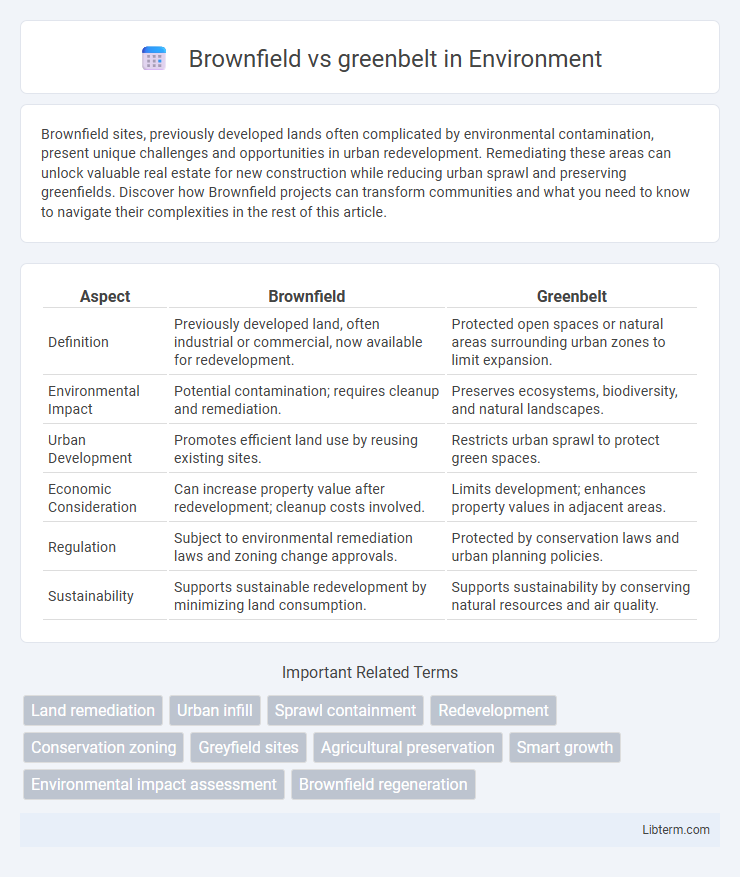Brownfield sites, previously developed lands often complicated by environmental contamination, present unique challenges and opportunities in urban redevelopment. Remediating these areas can unlock valuable real estate for new construction while reducing urban sprawl and preserving greenfields. Discover how Brownfield projects can transform communities and what you need to know to navigate their complexities in the rest of this article.
Table of Comparison
| Aspect | Brownfield | Greenbelt |
|---|---|---|
| Definition | Previously developed land, often industrial or commercial, now available for redevelopment. | Protected open spaces or natural areas surrounding urban zones to limit expansion. |
| Environmental Impact | Potential contamination; requires cleanup and remediation. | Preserves ecosystems, biodiversity, and natural landscapes. |
| Urban Development | Promotes efficient land use by reusing existing sites. | Restricts urban sprawl to protect green spaces. |
| Economic Consideration | Can increase property value after redevelopment; cleanup costs involved. | Limits development; enhances property values in adjacent areas. |
| Regulation | Subject to environmental remediation laws and zoning change approvals. | Protected by conservation laws and urban planning policies. |
| Sustainability | Supports sustainable redevelopment by minimizing land consumption. | Supports sustainability by conserving natural resources and air quality. |
Understanding Brownfield and Greenbelt Concepts
Brownfield sites are previously developed lands often characterized by existing infrastructure and potential contamination, requiring environmental remediation before redevelopment. Greenbelt areas are protected zones of open land surrounding urban regions, designated to limit urban sprawl and preserve natural landscapes. Understanding these concepts is crucial for sustainable urban planning, balancing redevelopment needs with environmental conservation.
Key Differences Between Brownfield and Greenbelt Sites
Brownfield sites are previously developed lands often contaminated, requiring remediation before reuse, while greenbelt sites are protected open spaces designated to limit urban sprawl and preserve natural ecosystems. Brownfield redevelopment typically involves urban infill and infrastructure renovation, promoting sustainable growth by reutilizing existing land, whereas greenbelt areas prioritize conservation and restrict construction to maintain environmental quality. The key difference lies in their purpose: brownfields focus on redevelopment and pollution cleanup, greenbelts emphasize preservation and controlled land use.
Environmental Impacts of Brownfield Development
Brownfield development involves redeveloping previously contaminated or industrial sites, which often requires extensive soil remediation to prevent the spread of pollutants and protect local ecosystems. This type of redevelopment reduces urban sprawl by repurposing existing land within cities, minimizing habitat destruction and preserving greenbelt areas designated for ecological conservation. Effective brownfield reclamation improves environmental health by reducing groundwater contamination and promoting sustainable land use, though careful management is essential to mitigate residual toxic substances.
Environmental Benefits of Greenbelt Preservation
Greenbelt preservation plays a crucial role in maintaining biodiversity, improving air quality, and regulating urban temperatures by providing natural carbon sinks and reducing heat islands. It supports sustainable water management through natural infiltration and filtration processes, which mitigates flooding and protects watersheds. Protecting greenbelts also enhances public health by offering recreational spaces and reducing pollution exposure in rapidly urbanizing regions.
Economic Considerations in Land Development
Brownfield redevelopment often requires higher initial investment due to site contamination cleanup but can yield significant economic benefits by revitalizing urban areas and leveraging existing infrastructure. Greenbelt development typically involves lower remediation costs but may incur expenses related to extending utilities and infrastructure into previously undeveloped land, potentially leading to urban sprawl. Economic considerations also include property value impacts, job creation potential, and long-term sustainability costs associated with either infill or expansion development strategies.
Planning and Regulatory Framework
Brownfield sites are typically subject to complex planning and regulatory frameworks involving environmental assessments, remediation requirements, and redevelopment incentives designed to mitigate contamination and encourage urban regeneration. Greenbelt areas, protected by strict zoning laws and land-use policies, prioritize conservation and restrict development to maintain open space, prevent urban sprawl, and preserve ecological integrity. Regulatory agencies often enforce stringent controls on brownfield revitalization projects to balance development goals with public health and environmental safety, contrasting with the limitations imposed on greenbelt development to sustain natural landscapes.
Brownfield Redevelopment Challenges and Opportunities
Brownfield redevelopment faces challenges such as soil contamination, high remediation costs, and complex regulatory requirements that can delay project timelines and increase financial risks. Opportunities arise from urban revitalization, the reuse of existing infrastructure, and potential incentives like tax credits and grants that encourage sustainable development. Transforming brownfields can reduce urban sprawl by directing growth inward, enhancing property values, and improving environmental health in former industrial areas.
Sustainability in Greenbelt Land Use
Greenbelt land use promotes sustainability by preserving natural ecosystems, reducing urban sprawl, and enhancing biodiversity through controlled development and conservation practices. Sustainable management of greenbelt areas supports carbon sequestration, improves air quality, and safeguards water resources, contributing to climate change mitigation. In contrast to brownfields, greenbelt preservation prioritizes long-term environmental health and ecosystem services, making it a crucial strategy for sustainable urban planning.
Community and Social Impacts
Brownfield redevelopment revitalizes urban areas by transforming contaminated or underused sites into functional spaces, promoting community engagement and improving public health. Greenbelt preservation maintains natural landscapes, supporting biodiversity and offering recreational areas that enhance social well-being. Balancing brownfield reuse with greenbelt conservation fosters sustainable urban growth while preserving community heritage and environmental quality.
Future Trends in Brownfield and Greenbelt Development
Future trends in brownfield development emphasize sustainable urban regeneration, incorporating advanced remediation technologies and mixed-use projects to revitalize neglected industrial sites. Greenbelt development is shifting towards preserving biodiversity and enhancing ecosystem services while balancing urban growth pressures through smart land-use planning and green infrastructure integration. Both strategies increasingly leverage digital tools like GIS and AI for optimizing land restoration and conservation efforts, promoting resilient and adaptive urban landscapes.
Brownfield Infographic

 libterm.com
libterm.com